An action game is a video game genre that emphasizes physical challenges, including hand–eye coordination and reaction time. The genre includes a large variety of sub-genres, such as fighting games, beat 'em ups, shooter games, rhythm games and platform games. Multiplayer online battle arena and some real-time strategy games are also considered action games.

Wonder Boy in Monster Land, known by its original arcade release as Wonder Boy: Monster Land, is a platform video game developed by Westone Bit Entertainment and released by Sega in Japanese arcades in 1987 and for the Master System in 1988, with a number of other home computer and console ports following. The game is the sequel to the 1986 game Wonder Boy and takes place eleven years after the events in the previous game. After enjoying over a decade of peace on Wonder Land following the defeat of the evil King by Tom-Tom, later bestowed the title "Wonder Boy", a fire-breathing dragon called the MEKA dragon appeared; he and his minions conquered Wonder Land, turning it into "Monster Land". The people, helpless due to their lack of fighting skill, call for Wonder Boy, now a teenager, to destroy the monsters and defeat the MEKA dragon. Players control Wonder Boy through twelve linear levels as he makes his way through Monster Land to find and defeat the MEKA dragon. Players earn gold by defeating enemies and buy weapons, armor, footwear, magic, and other items to help along the way.
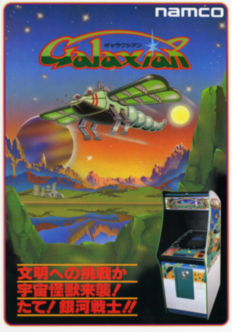
Galaxian is a 1979 fixed shooter arcade video game developed and published by Namco. The player assumes control of the Galaxip starfighter in its mission to protect Earth from waves of aliens. Gameplay involves destroying each formation of aliens, who dive down towards the player in an attempt to hit them.

Pssst is an action video game developed and published by Ultimate Play the Game that was released for the ZX Spectrum in June 1983. In the game, Robbie the Robot has to protect his plant as it is attacked by various insects, each of which needs a different repellent to neutralise it. Pssst was the second game to be released by Ultimate, after Jetpac.

Dig Dug is a maze arcade video game released by Namco in 1982. It was distributed in North America by Atari, Inc. The player digs underground tunnels to attack enemies in each level, by either inflating them to bursting or crushing them underneath rocks.

Katamari Damacy is a third-person puzzle-action video game developed and published by Namco for the PlayStation 2. It was released in Japan in March 2004 and later in North America in September. Designer Keita Takahashi struggled to pitch the game to Namco's superiors, eventually seeking student aid from the Namco Digital Hollywood Game Laboratory to develop the project for less than US$ 1 million. As director, Takahashi emphasized concepts of novelty, ease of understanding, and enjoyment.

In video gaming, the HUD or status bar is the method by which information is visually relayed to the player as part of a game's user interface. It takes its name from the head-up displays used in modern aircraft.
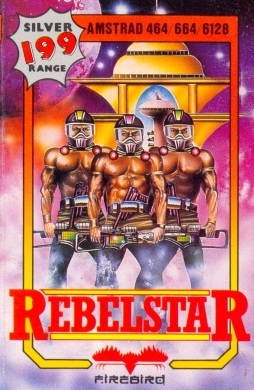
The Rebelstar games are a series of turn-based tactics video games designed by Julian Gollop. Rebelstar Raiders was published in 1984 by Red Shift for the ZX Spectrum. It was reworked in machine code as Rebelstar, published by Firebird in 1986. A sequel, Rebelstar II, was published in 1988 by Silverbird. Rebelstar, but not its sequel, was also adapted for the Amstrad CPC home computer.
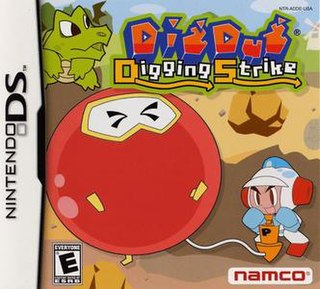
Dig Dug: Digging Strike is a 2005 maze video game published by Namco for the Nintendo DS. In Europe, the game was published by Atari Europe. It is the fifth entry in the Dig Dug video game series, and the second to be made for a home platform. The game follows series protagonist Taizo Hori, bitter about his son Susumu getting more attention than him—after a chain of tropical islands is threatened by monsters, Taizo sets out to defeat them and reclaim his fame. Gameplay combines mechanics established in the original Dig Dug and its sequel Dig Dug II, centered around sinking a large "boss" character into the ocean by digging under large stakes in the ground.

A fast loader is a software program for a home computer, such as the Commodore 64 or ZX Spectrum, that accelerates the speed of file loading from floppy disk or compact cassette.

Dragon Spirit is a 1987 vertical-scrolling shooter arcade game developed and published by Namco. In North America, it was distributed by Atari Games. Controlling the dragon Amur, the player must complete each of the game's nine areas to rescue the princess Alicia from the demon Zawell. Similar to Namco's own Xevious, Amur has a projectile weapon for destroying air-based enemies and a bomb for destroying ground enemies. It ran on the Namco System 1 arcade board.

Ridge Racer is a 1993 racing video game developed and published by Namco. It was released initially on the Namco System 22 arcade system board and ported to the PlayStation console in 1994. It is the first title in the Ridge Racer series released for arcades and home consoles.
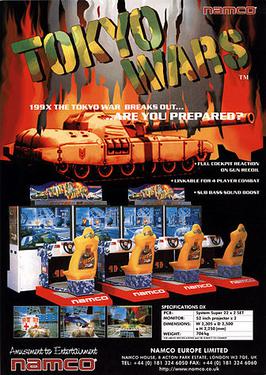
Tokyo Wars is a 1996 first-person shooter arcade game developed and published by Namco.
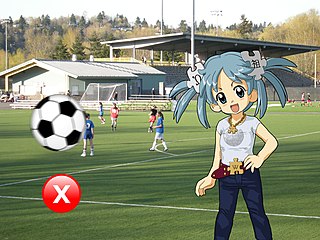
In video games, a quick time event (QTE) is a method of context-sensitive gameplay in which the player performs actions on the control device shortly after the appearance of an on-screen instruction/prompt. It allows for limited control of the game character during cut scenes or cinematic sequences in the game. Performing the wrong prompt, mistiming the action, or not performing any action at all results in the character's failure at their task, resulting in a death/failure animation and often an immediate game over or the loss of a life, with some games providing a lesser but significant penalty of sorts instead.

In video games, an open world is a virtual world in which the player can approach objectives freely, as opposed to a world with more linear and structured gameplay. Notable games in this category include The Legend of Zelda (1986), Grand Theft Auto V (2013) and Minecraft (2011).
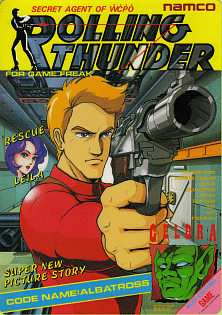
Rolling Thunder is a run and gun video game developed by Namco in Japan and Europe and released in 1986 as a coin-operated arcade video game using the Namco System 86 hardware. It was distributed in North America by Atari Games. The player takes control of a secret agent who must rescue his female partner from a terrorist organization. Rolling Thunder was a commercial success in arcades, and it was released for various home computer platforms in 1987 and the Nintendo Entertainment System in 1989. The original arcade game has been included in various classic game compilations as well. It influenced later arcade action franchises such as Shinobi and Time Crisis, which borrowed mechanics such as taking cover behind crates.

Mini Metro is a puzzle strategy video game developed by New Zealand indie development team Dinosaur Polo Club. Players are tasked with constructing an efficient rail transit network for a rapidly growing city. The game's visual style makes use of bold colours and simple geometry to replicate the appearance of modern transit maps. The game uses a procedural audio system to generate sounds based on the player actions and transit network, with inspiration from works of minimal music.

Mr. Driller 2 is a puzzle video game developed and published by Namco, and the second game in the Mr. Driller series. It was released for the arcades in 2000, and was ported to the Game Boy Advance and Windows in 2001, and is available in emulated form via the Virtual Console on the Wii U. The game introduces two new characters to the series, Puchi, and Anna.

A cutscene or event scene is a sequence in a video game that is not interactive, interrupting the gameplay. Such scenes are used to show conversations between characters, set the mood, reward the player, introduce newer models and gameplay elements, show the effects of a player's actions, create emotional connections, improve pacing or foreshadow future events.
A horror game is a video game genre centered on horror fiction and typically designed to scare the player. The term may also be used to describe tabletop games with horror fiction elements.



















